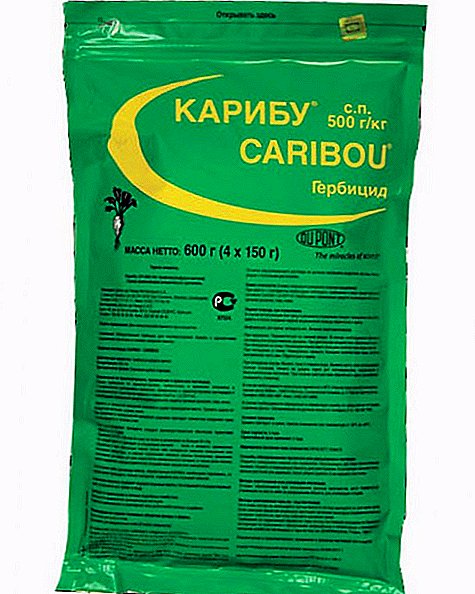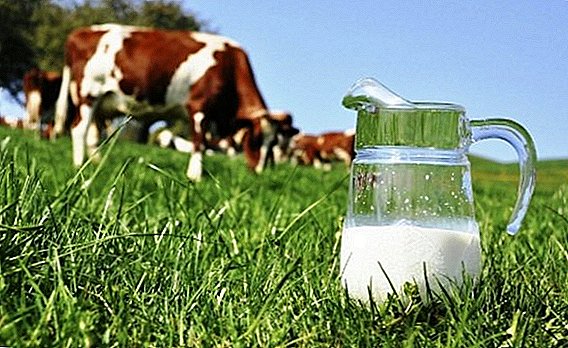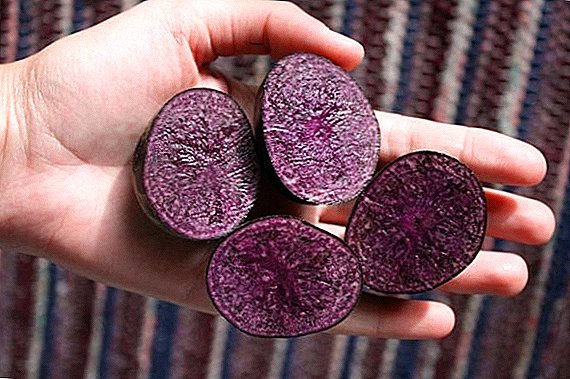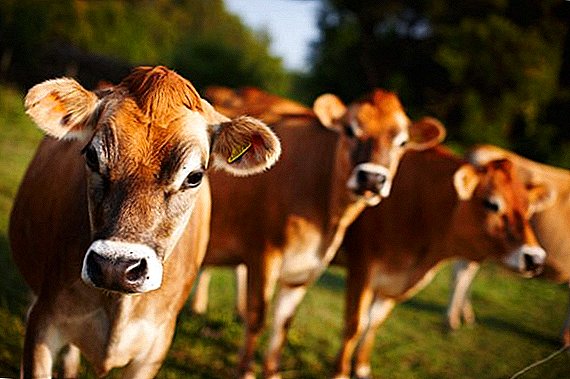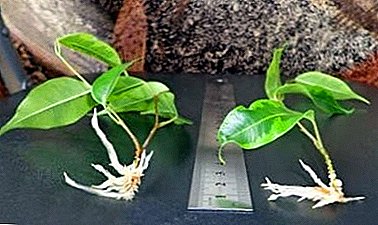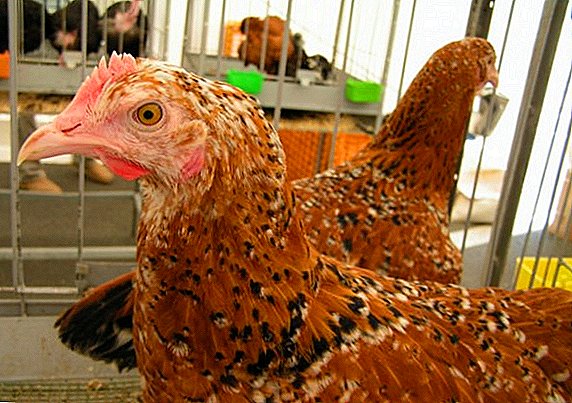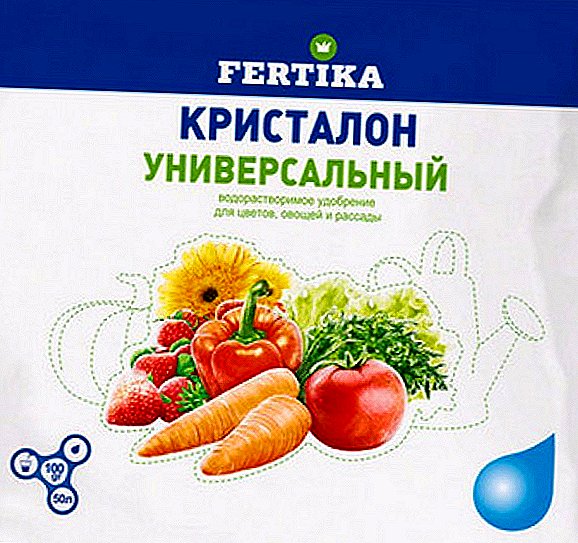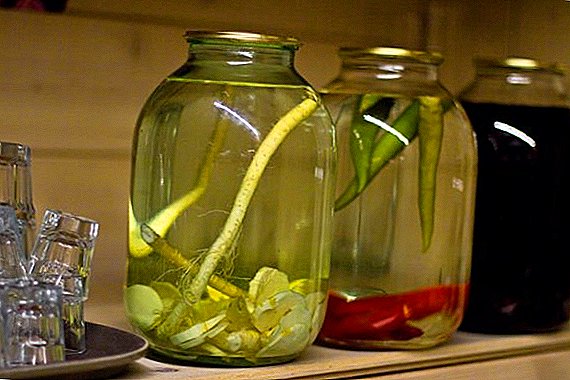 The snow-white soft fur, small eyes and a curious attractive face is a hermelin rabbit.
The snow-white soft fur, small eyes and a curious attractive face is a hermelin rabbit.
We will talk about this breed in more detail today, about the history, the description and about the conditions in which the animal should live.
History of origin
In the 19th century, rabbit breeders became acquainted with representatives of the red-eyed hermelinae, a new breed bred by Western European breeders. These representatives were obtained by crossing several breeds:
- albinos;
- miniature silver;
- Dutch;
- wild individuals.
Check out the breeds of ornamental rabbits.In the twenties of the twentieth century, blue-eyed individuals were bred. The first European breed standard was approved in Austria in 1992.

Breed description
The final breed standard was approved in 1997, and now it is oriented towards it.
Familiarize yourself with the characteristic features of dwarf, color dwarf, foxes of dwarf, Vienna blue, lion-headed rabbits.
Appearance
According to the standard, the description of the hermelin is as follows:
- head: large, round, the width of the frontal part in females is 50 mm, in males it is 55 mm, the neck is short, it practically merges with the body;
- ears: with a coat, erect, with smoothly rounded tips, set close, ideal length - 5.5 cm;
- eyes: slightly convex, two colors are allowed - red and blue;
- torso: in the form of a cylinder, compact, the rabbit has no dewlap. The tail is tight to the body, small size. The croup is rounded;
- limbs: the front pair is shorter than the hind legs, the claws are not painted;
- color: exceptionally white, no yellowing or blotting is allowed;
- weight: ideal body weight - from 1 kg to 1300 kg;
- lifespan: 8-12 years old.

Character traits
An animal created for life in society. Hermelin is friendly, inquisitive, affectionate, in most cases an obedient beast. All these qualities are developed with constant communication, if you do not pay attention to it, then the baby will grow stubborn and capricious.
Dwarf rabbit is very active, willingly plays, easy to train, taking it as another fun. The kid easily gets used to the family, but is prone to stress, so you need to eliminate the loud noise and the situations in which he may be frightened.
Did you know? The first international club of hermelin breeders was established in Dresden in 1908.
What to look for when buying a rabbit
It is difficult to distinguish the dwarf rabbit and the usual at a young age, as all rabbits are small in size. You need to buy an animal in the nursery, do not hesitate to ask to show the documents and the parental couple. The distinguishing features of a hermelin are:
The distinguishing features of a hermelin are:
- snow white wool. Neither spots, nor yellowing should not be;
- the ears are only standing, the tips of the ears are not sharp, but gently rounded;
- muzzle is also round, not sharp;
- hind legs stronger and longer than the front;
- small tail.
Did you know? Decorative rabbits are loved and many famous people love to get started. Among them are Shakira, Sharon Stone, Olga Sumskaya, Zlata Ognevich.
When buying, you should also make sure that the animal is healthy. Signs of a healthy individual:
- clean, no discharge eyes;
- activity and display of curiosity;
- clean ears;
- glossy and thick hairless without hairs;
- even breathing without wheezing and shaking.

Characteristics of the content of hermelin
In the warm season, a pet can and even needs to be carried out to fresh air, so that no one will frighten him, it is advisable to choose lonely places. If you have a private house, you can build for the summer an aviary enclosed with a net for the safety of the baby.
Learn how to care for a decorative rabbit in the apartment.
The necessary conditions
The rabbit dwelling is placed on a flat and stable surface. It should not be located in a draft-blown space, as well as near heating devices. It is also undesirable to put in a place that is under direct sunlight. The optimal conditions for hermelinov is a temperature of 18-20 ° C and humidity within 50%.
Cell selection and filling
Choosing a cage, expect that it will be filled with various accessories. In addition, the animal needs a free space about five times its size. Approximate dimensions of the cell are 80x60x80 cm. Housing arrangement:
- toilet tray;
- feeding trough and drinking bowl;
- holiday house with hay;
- toys, bars for teeth;
- litter of sawdust, hay or soft straw.

It is better to buy a cage with a removable tray to make it easier to clean, preferably with unpainted metal rods. The most convenient bunker type feeders, and drinkers - nipple.
Important! It is necessary to accustom to a tray at once, it is best to look at the purchase where it stood at the breeder.
Hermelin Care and Hygiene
Pet care is not difficult: the animal is cleanly. Due to weak immunity, it is not recommended to bathe it. Regularly, you need to comb the hair, getting rid of dead hair and trim the claws.
Pet stores have all the necessary accessories for both procedures. A prerequisite for a good mood and health of a pet is a daily walk in the sun, at least two hours. Fluffies, like people, need vitamin D, which is synthesized under ultraviolet light.
Important! Sanitary disinfection is carried out once every two weeks; you can use chlorinated detergents, but rinse objects until the smell is completely removed.Cleaning of the rabbit dwelling is carried out according to the following rules:
- Pallet cleaned daily.
- The dishes are cleaned after each meal, and the drinker is daily.
- The litter is changed once a week (provided that the baby goes to the tray, and not by).
- Tray is cleaned daily.

What to feed rabbits
The characteristics of digestion in rabbits require frequent consumption of food. The fact is that everything that enters the stomach is superimposed in layers, each subsequent layer of food promotes the lower one into the intestine. Therefore, the pet should always have something edible. Also watch out for drinkers, the water should always be clean and fresh. It is better to fill the drinking bowl with separated or filtered water.
Find out what are the main nutrition tenets of ornamental rabbits.As sources of vitamins and minerals must be present green food:
- carrots - carotene, retinol, almost the entire group of vitamin B, iodine, fluorine (250 g per day);
- cabbage - fiber, folic and ascorbic acid, vitamin K, potassium, magnesium, calcium (270 g);
- beets (fodder or sugar) - vitamins A, B9, C, fiber, phosphorus, sulfur, chlorine (250 g);
- celery, spinach, salad - vitamin C, B, K, E, lutein (up to 500 g per day);
- apples - iron, copper, vitamins A, C, choline (70 g);
- branches of fruit trees and shrubs - for grinding teeth (should always be available);
- meadow grass - up to 500 g per day.

Vitamins and minerals obtained with succulent feeds support immunity, and besides him, all systems and internal organs of the body. The disadvantage immediately affects the appearance of the pet: dull hair, lethargy, peeling of the skin, and then on health.
Learn what supplements, vitamins should be given to rabbits.In winter, during the absence of greenery and fresh fruits, bone meal, chalk, crushed egg shells are added to the feed. The diet, in addition to hay and greens, also includes cereal mixtures. It is best to buy special formulations in pet stores, because they are balanced by all the necessary elements.
Be sure to verify the tightness of the packaging and shelf life, after opening in the absence of foreign odors and mold.
You can not give:
- dining room (red) beetroot;
- red cabbage;
- porridges;
- nuts;
- dried fruits;
- food from the table (flour, sweet, smoked and salted).

Breeding rabbits
Basic breeding rules:
- Pick up a parent pair weighing from 1 kg to 1.3 kg.
- It is undesirable to take females younger than seven months and males younger than eight.
- Individuals must be healthy and vaccinated (de-worming is required before pregnancy).
- It is necessary to conduct several coatings.
Learn how to deal with rabbits, how to determine rabbit suckling, how to feed a rabbit after a check.The female wears from 29 to 31 days, during this time you need to lay the floor in her cage with a soft, deep bedding. If she gives birth on an empty floor, babies can freeze. On the third week of pregnancy, the female increases the amount of feed, it is desirable to give more vegetables and fruits. After the birth of the brood, you need to ensure that the trough and the feeder are always full, but you should not bother the female again.

Diseases and breed defects
Germelins are gentle creatures and, unfortunately, are prone to a number of health problems:
- viral and infectious diseases (cold, bronchitis, rhinitis, conjunctivitis, rabies, myxomatosis, hemorrhagic virus);
- gastrointestinal tract diseases (diarrhea, constipation, LCD stasis, trichobezozoar, ulcer, dysbacteriosis);
- injuries (dislocation, contusion, sprain);
- skin diseases;
- heatstroke;
- Nervous shocks.
Important! To prevent parasitic ailments, children at three weeks of age are dewormed, repeated ten days later.Be sure to vaccinate individuals:
- from pasteurellosis in 28 days;
- complex from myxomatosis and viral hemorrhagic at the age of 35 days;
- from rabies at the age of two months.
If you need a friendly and cheerful bundle of happiness, you have children who are ready to care for a pet, the Hermelin is what you need. Surround the baby with care and love, and he will answer you the same.


